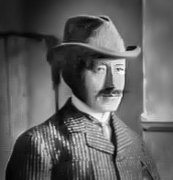



During his early years, Marconi had an interest in science and electricity and in the early 1890s he began working on the idea of "wireless telegraphy" This was not a new idea; numerous investigators and inventors had been exploring wireless telegraph technologies and even building systems using electric conduction, electromagnetic induction and optical signalling for over 50 years, but none had proven technically and commercially successful. A relatively new development came from Heinrich Hertz, who in 1888 demonstrated that one could produce and detect electromagnetic radiation, at the time commonly called "Hertzian" waves, and now generally referred to as radio waves.
Marconi's first transmitter incorporating a monopole antenna. It consisted of an elevated copper sheet connected to a Righi spark gap powered by an induction coil with a telegraph key to switch it on and off to spell out text messages in Morse code.
Marconi, then twenty years old, began to conduct experiments in radio waves, building much of his own equipment in the attic of his home at the Villa Griffone in Pontecchio, Italy with the help of his butler Mignani. He built on Hertz's original experiments and, at the suggestion of Righi, began using a coherer, an early detector based on the 1890 findings of French physicist Edouard Branly and used in Lodge's experiments, that changed resistance when exposed to radio waves. In the summer of 1894, he built a storm alarm made up of a battery, a coherer, and an electric bell, which went off when it picked up the radio waves generated by lightning.
He continued to work in the attic. Late one night in December 1894 he demonstrated a radio transmitter and receiver to his mother, a set-up that made a bell ring on the other side of the room by pushing a telegraphic button on a bench.
In the summer of 1895, Marconi moved his experimentation outdoors and continued to experiment on his father's estate in Bologna. He tried different arrangements and shapes of antenna but even with improvements he was only able to transmit signals up to one-half mile, a distance Oliver Lodge had predicted in 1894 as the maximum transmission distance for radio waves.
A breakthrough came that summer when Marconi found that much greater range could be achieved after he raised the height of his antenna and, borrowing from a technique used in wired telegraphy, grounding his transmitter and receiver. With these improvements the system was capable of transmitting signals up to 2 miles (3.2 km) and over hills. The monopole antenna reduced the frequency of the waves compared to the dipole antennas used by Hertz, and radiated vertically polarized radio waves which could travel longer distances.
Marconi wrote to the Ministry of Post and Telegraphs, then under the direction of the honourable Pietro LaCava, explaining his wireless telegraph machine and asking for funding. He never received a response to his letter.
Finding little interest or appreciation for his work in Italy, Marconi travelled to London in early 1896 at the age of 21, accompanied by his mother, to seek support for his work. (He spoke fluent English in addition to Italian.) Marconi arrived at Dover and the Customs officer opened his case to find various contraptions and apparatus. The customs officer immediately contacted the Admiralty in London. While there, Marconi gained the interest and support of William Preece, the Chief Electrical Engineer of the British Post Office.
Marconi made his first demonstration of his system for the British government in July 1896. A further series of demonstrations for the British followed. By March 1897, Marconi had transmitted Morse code signals over a distance of about 6 kilometres (3.7 mi) across Salisbury Plain. On 13 May 1897, Marconi sent the world's first ever wireless communication over open sea. The experiment, based in Wales, witnessed a message transversed over the Bristol Channel from Flat Holm Island to Lavernock Point in Penarth, a distance of 6 kilometres (3.7 mi).
Numerous additional demonstrations followed, and Marconi began to receive international attention.
Marconi sailed to the United States at the invitation of the New York Herald newspaper to cover the America's Cup races off Sandy Hook, New Jersey. The transmission was done aboard the SS Ponce, a passenger ship of the Porto Rico Line. Marconi left for England on 8 November 1899 on the American Line's SS Saint Paul, and he and his assistants installed wireless equipment aboard during the voyage. On 15 November Saint Paul became the first ocean liner to report her imminent return to Great Britain by wireless when Marconi's Royal Needles Hotel radio station contacted her 66 nautical miles off the English coast.
At the turn of the 20th century, Marconi began investigating the means to signal completely across the Atlantic in order to compete with the transatlantic telegraph cables. Marconi established a wireless transmitting station at Marconi House, Rosslare Strand, Co. Wexford in 1901 to act as a link between Poldhu in Cornwall, England and Clifden in Co. Galway, Ireland. He soon made the announcement that the message was received at Signal Hill in St John's, Newfoundland (now part of Canada) on 12 December 1901, using a 500-foot (150 m) kite-supported antenna for reception. Signals transmitted by the company's new high-power station at Poldhu, Cornwall. The distance between the two points was about 2,200 miles (3,500 km).
It was heralded as a great scientific advance, yet there also was and continues to be considerable scepticism about this claim. The exact wavelength used is not known, but it is fairly reliably determined to have been in the neighbourhood of 350 meters (about 850 kHz). The tests took place at a time of day during which the entire transatlantic path was in daylight. We now know (although Marconi did not know then) that this was the worst possible choice. At this medium wavelength, long distance transmission in the daytime is not possible because of heavy absorption of the skywave in the ionosphere.
It was not a blind test. Marconi knew in advance to listen for a repetitive signal of three clicks, signifying the Morse code letter S. The clicks were reported to have been heard faintly and sporadically. There was no independent confirmation of the reported reception, and the transmissions were difficult to distinguish from atmospheric noise. (A detailed technical review of Marconi's early transatlantic work appears in John S. Belrose's work of 1995.) The Poldhu transmitter was a two-stage circuit.
Feeling challenged by skeptics, Marconi prepared a better organised and documented test. In February 1902, the SS Philadelphia sailed west from Great Britain with Marconi aboard, carefully recording signals sent daily from the Poldhu station. The test results produced coherer-tape reception up to 1,550 miles (2,490 km), and audio reception up to 2,100 miles (3,400 km). The maximum distances were achieved at night, and these tests were the first to show that radio signals for medium wave and longwave transmissions travel much farther at night than in the day. During the daytime, signals had only been received up to about 700 miles (1,100 km), less than half of the distance claimed earlier at Newfoundland, where the transmissions had also taken place during the day. Because of this, Marconi had not fully confirmed the Newfoundland claims, although he did prove that radio signals could be sent for hundreds of kilometres, despite some scientists' belief that they were essentially limited to line-of-sight distances.
On 17 December 1902, a transmission from the Marconi station in Glace Bay, Nova Scotia, Canada became the world's first radio message to cross the Atlantic from North America. In 1901, Marconi built a station near South Wellfleet, Massachusetts that sent a message of greetings on 18 January 1903 from United States President Theodore Roosevelt to King Edward VII of the United Kingdom. However, consistent transatlantic signalling was difficult to establish.
Marconi began to build high-powered stations on both sides of the Atlantic to communicate with ships at sea, in competition with other inventors. In 1904, a commercial service was established to transmit nightly news summaries to subscribing ships, which could incorporate them into their on-board newspapers. A regular transatlantic radio-telegraph service was finally begun on 17 October 1907 between Clifden Ireland and Glace Bay, but even after this the company struggled for many years to provide reliable communication to others.
Titanic
The role played by Marconi Co. wireless in maritime rescues raised public awareness of the value of radio and brought fame to Marconi, particularly the sinkings of the RMS Titanic on 15 April 1912 and the RMS Lusitania on 7 May 1915.
On 18 June 1912, Marconi gave evidence to the Court of Inquiry into the loss of Titanic regarding the marine telegraphy's functions and the procedures for emergencies at sea. Britain's postmaster-general summed up, referring to the Titanic disaster: "Those who have been saved, have been saved through one man, Mr. Marconi and his marvellous invention." Marconi was offered free passage on Titanic before she sank, but had taken Lusitania three days earlier. As his daughter Degna later explained, he had paperwork to do and preferred the public stenographer aboard that vessel.
Over the years, the Marconi companies gained a reputation for being technically conservative, in particular by continuing to use inefficient spark-transmitter technology which could only be used for radio-telegraph operations, long after it was apparent that the future of radio communication lay with continuous-wave transmissions which were more efficient and could be used for audio transmissions. Somewhat belatedly, the company did begin significant work with continuous-wave equipment beginning in 1915, after the introduction of the oscillating vacuum tube (valve). The New Street Works factory in Chelmsford was the location for the first entertainment radio broadcasts in the United Kingdom in 1920, employing a vacuum tube transmitter and featuring Dame Nellie Melba. In 1922, regular entertainment broadcasts commenced from the Marconi Research Centre at Great Baddow, forming the prelude to the BBC, and he spoke of the close association of aviation and wireless telephony in that same year at a private gathering with Florence Tyzack Parbury, and even spoke of interplanetary wireless communication.
In 1943, the Supreme Court of the United States handed down a decision on Marconi's radio patents restoring some of the prior patents of Oliver Lodge, John Stone Stone, and Nikola Tesla. The decision was not about Marconi's original radio patents and the court declared that their decision had no bearing on Marconi's claim as the first to achieve radio transmission, just that since Marconi's claim to certain patents were questionable, he could not claim infringement on those same patents. There are claims the high court was trying to nullify a World War I claim against the United States government by the Marconi Company via simply restoring the non-Marconi prior patent.
Otis Pond, an engineer then working for Tesla, said, "Looks as if Marconi got the jump on you." Tesla replied, "Marconi is a good fellow. Let him continue. He is using seventeen of my patents."
It wasn't until 1943, a few months after Tesla's death, that the U.S. Supreme Court upheld Tesla's radio patent number 645,576.
![]() Exerpt from WikiPedia (page opens in new browser window)
Exerpt from WikiPedia (page opens in new browser window)
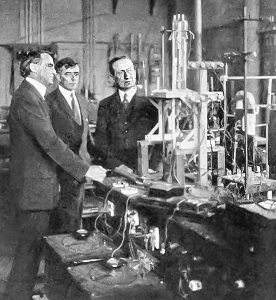
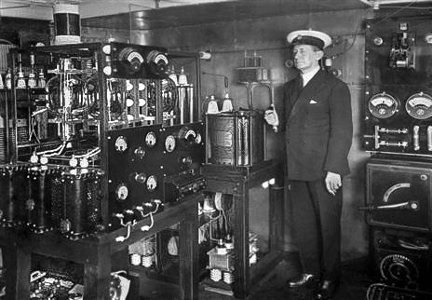
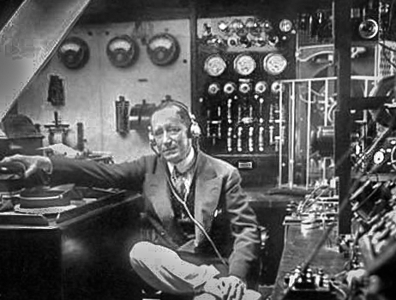
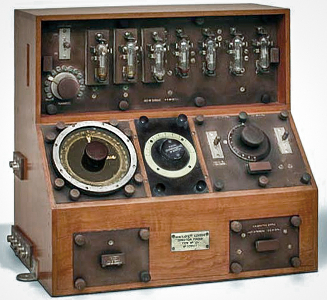
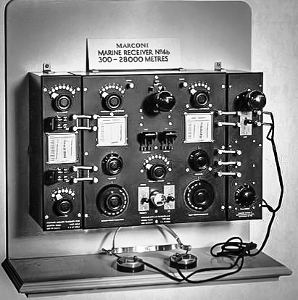
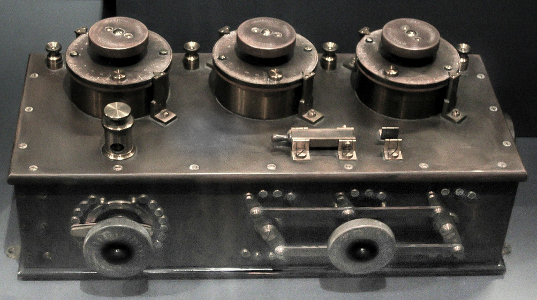
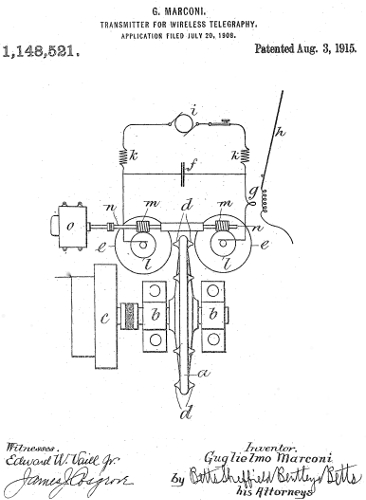 RMS Titanic radio operators Jack Phillips and Harold Bride were not employed by the White Star Line but by the Marconi International Marine Communication Company. After the sinking of the ocean liner on 15 April 1912, survivors were rescued by the RMS Carpathia of the Cunard Line. Also employed by the Marconi Company was David Sarnoff, who later headed RCA. Wireless communications were reportedly maintained for 72 hours between Carpathia and Sarnoff, but Sarnoff's involvement has been questioned by some modern historians. When Carpathia docked in New York, Marconi went aboard with a reporter from The New York Times to talk with Bride, the surviving operator.
RMS Titanic radio operators Jack Phillips and Harold Bride were not employed by the White Star Line but by the Marconi International Marine Communication Company. After the sinking of the ocean liner on 15 April 1912, survivors were rescued by the RMS Carpathia of the Cunard Line. Also employed by the Marconi Company was David Sarnoff, who later headed RCA. Wireless communications were reportedly maintained for 72 hours between Carpathia and Sarnoff, but Sarnoff's involvement has been questioned by some modern historians. When Carpathia docked in New York, Marconi went aboard with a reporter from The New York Times to talk with Bride, the surviving operator.
![]() So Who Really Invented Radio? (page opens in new browser window)
So Who Really Invented Radio? (page opens in new browser window)
![]() Return to Radio Pictures
Return to Radio Pictures
![]() Return to MCRN Home
Return to MCRN Home